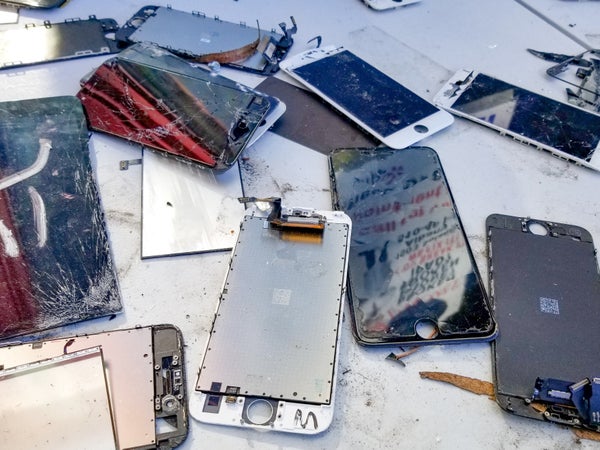This article was published in Scientific American’s former blog network and reflects the views of the author, not necessarily those of Scientific American
Hardware in general, and smartphones in particular, have taken over our lives so quickly that few of us have had the chance to think about what happens to them when we no longer use them. The answer is that they become a huge environmental and health problem in the Global South’s landfill sites.
We don’t hear much about this problem because it is out of sight, out of mind.
Electronic waste is currently 5 percent of all global waste, and it is set to increase exponentially as more of us own multiple smartphones, laptops and power banks—few of which are likely to be repaired or recycled at the end of their lives.
On supporting science journalism
If you're enjoying this article, consider supporting our award-winning journalism by subscribing. By purchasing a subscription you are helping to ensure the future of impactful stories about the discoveries and ideas shaping our world today.
Instead, they end up in places like Agbogbloshie on the outskirts of Ghana’s capital, Accra. It is the biggest e-waste dump in the world, where 10,000 informal workers wade through tons of discarded goods as part of an enormous, informal recycling process. They risk their health for the sake of scraping out a livelihood searching for the precious metals that are found in our discarded smartphones.
But Agbogbloshie legally should not exist. The Basel Convention, a 1989 treaty aimed at preventing developed nations from unauthorized dumping of e-waste in less developed countries, should stop toxic dumps like this from taking shape.
The e-waste industry, however, circumvents regulation by exporting it to poor countries like Ghana labelled as “secondhand goods”, knowing full well that it is not heading for a used electronics store in the capital but a toxin-ridden landfill site on its outskirts.
A recent report found Agbogbloshie contained some of the most hazardous chemicals on earth. This is not surprising to us in the sustainable tech world: smartphones contain mercury, lead and even arsenic.
Reportedly, one egg from a free-range chicken in Agbogbloshie contained chlorinated dioxins (which can cause cancer and damage the immune system) at a level some 220 times greater than a limit set by the European Food Safety Authority. Most worryingly, these toxins are free to contaminate the broader food and water system. This should concern us all, since some of Ghana’s top exports are cocoa and nuts.
The source of the problem is Europe and North America: the European Union and the United States alone contribute to almost one half of the total e-waste generated annually, amounting to 50 million metric tons.
And some of those governments have started to take responsibility for their consumers’ waste, with the German development agency GIZ currently engaged ina €5 million ($5.5 million) project that includes a sustainable recycling system at Agbogbloshie, along with a health clinic and football pitch for workers.
Governments cannot solve the problem alone, however. There is an almost limitless consumer demand for hardware, and governments do not have bottomless pockets, especially when their green policies are focused on more high-profile issues like carbon emissions.
Only the manufacturers can fix this, by creating a circular hardware economy. Although the left may be keen to placate the green lobby with muscular regulation, a more economically sustainable and politically possible solution is through incentivizing hardware manufacturers to make the repair, reuse and recycling of hardware profitable, or at least cost-neutral.
This has the added benefit of not pitting governments and regulators against hardware manufacturers’ lobbyists, whose power was evident when Apple successfullyopposed California’s “right to repair” bill earlier this year. This kind of conflict is likely to become more regular if manufacturers do not make sustainability a part of their design process, perhaps leading regulators in future to be more heavy-handed.
On paper, it should be financially attractive for smartphone manufacturers to recycle their hardware. The material value alone of the world’s e-waste is $62.5 billion, more than the GDP of most countries.
There is 100 times more gold in a metric ton of mobile phones than in the same amount of gold ore; up to 7 percent of the world’s gold may currently be contained in e-waste.
If it is economically viable to mine gold ore, it can be just as profitable to mine iPhones, with the right technology and processes.
This would also future-proof manufacturers’ supply chains since there are concerns about the long-term availability of raw materials they need like gold, platinum, cobalt, aluminum and tin.
Before manufacturers even get to the costly process of developing these recycling and extraction systems, there is an opportunity for them to simply ask consumers to trade in their old phones. They could then act as brokers for resale of these items to emerging markets that are full of aspirational consumers eager to own their first smartphone—even if it’s an iPhone 6, not an 11.
As well as the financial benefit, they will be able to capitalize on the public relations opportunity and block cheaper smartphone manufacturers like China’s Huawei from establishing a foothold and building customer loyalty in emerging markets.
These are policies that could be as popular in Silicon Valley as in Accra. It is high time our governments and industries started to push for them.
